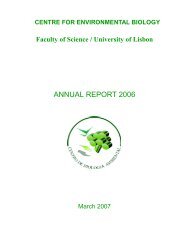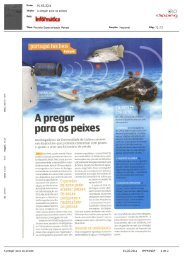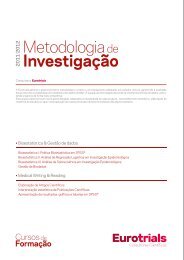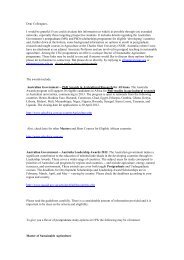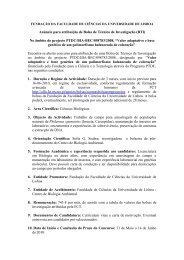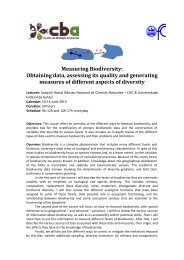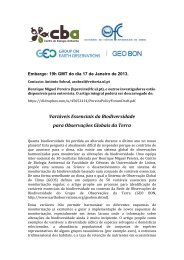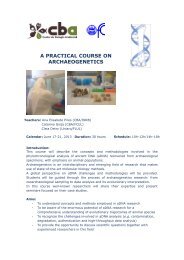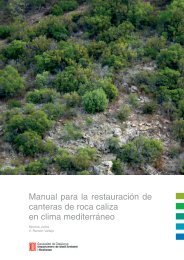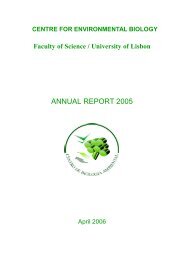European Red List of Vascular Plants - European Commission
European Red List of Vascular Plants - European Commission
European Red List of Vascular Plants - European Commission
Create successful ePaper yourself
Turn your PDF publications into a flip-book with our unique Google optimized e-Paper software.
particularly important to Europe in terms <strong>of</strong> production<br />
quantity and/or value were selected. In terms <strong>of</strong> production<br />
quantity, there are 18 crops or crop groups <strong>of</strong> which<br />
Europe produced an average <strong>of</strong> >1MT in five years from<br />
2003–2007 that have CWR native to Europe that may<br />
be important for crop improvement: wheat, sugar beet,<br />
barley, grapes, rapeseed, apples, oats, cabbages (and other<br />
brassicas), rye, olives, carrots and turnips, onions, peaches<br />
and nectarines, peas, lettuce and chicory, pears, plums<br />
and sloes, and strawberries (Figure 10). Note that there<br />
are other economically important crops excluded from<br />
this list (e.g., potato) that have wild relatives in Europe,<br />
but they are very distant wild relatives – the centre <strong>of</strong><br />
diversity <strong>of</strong> the potato gene pool being in South America<br />
– and are therefore not considered a priority in terms <strong>of</strong><br />
their potential as gene donors for crop improvement.<br />
Figure 11 shows the average value <strong>of</strong> crops or crop groups<br />
produced in Europe over five years from 2004–2008 that<br />
have CWR native to Europe which may be important<br />
for crop improvement. All <strong>of</strong> the crops or crop groups<br />
included in this analysis are also included in the priority<br />
list <strong>of</strong> human food crops based on production quantity.<br />
This selection <strong>of</strong> 18 crops or crop groups is found within<br />
19 genera within which there are 279 species native to<br />
Europe.<br />
Step 4: CWR <strong>of</strong> animal food crops<br />
The production quantity and economic value data that<br />
are available for human food crops are not available for<br />
animal food crops on an individual crop basis; therefore,<br />
it is not possible to prioritize animal food crops according<br />
to these criteria. However, <strong>of</strong> the 279 CWR species<br />
identified in the high priority human food CWR group,<br />
106 are wild relatives <strong>of</strong> forage and/or fodder crops, as<br />
well as human food crops; therefore, CWR <strong>of</strong> a number<br />
<strong>of</strong> animal food crops are included in this list.<br />
Step 5: CWR <strong>of</strong> other human and animal food crops<br />
To add to the high priority list <strong>of</strong> 279 species described<br />
above, Annex I <strong>of</strong> the International Treaty on Plant<br />
Genetic Resources for Food and Agriculture (ITPGRFA)<br />
was also used as the basis for species selection. This is a<br />
list <strong>of</strong> PGRFA established according to criteria <strong>of</strong> food<br />
security and interdependence and includes 78 genera<br />
containing human or animal food crops. Fifty-nine <strong>of</strong><br />
these genera contain taxa that are native to Europe, some<br />
<strong>of</strong> which are already included in the high priority CWR<br />
list defined above. Annex I <strong>of</strong> the ITPGRFA is divided<br />
into two lists: 1) human food crops, and 2) forages.<br />
The human food crop list mainly lists entire genera<br />
because the CWR <strong>of</strong> these crops are recognized as being<br />
important for food security. The forage list only includes<br />
specific species because a) the crops are mainly selections<br />
from wild species and the CWR are less likely to be used<br />
for crop improvement, and b) many <strong>of</strong> the forage genera<br />
contain a very large number <strong>of</strong> species; for example,<br />
Festuca contains 204 species native to Europe.<br />
Additional human food crop genera listed in Annex I <strong>of</strong><br />
the ITPGRFA that were included in the list <strong>of</strong> CWR for<br />
assessment are: Asparagus, brassica complex (Armoracia,<br />
Barbarea, Camelina, Crambe, Diplotaxis, Eruca, Isatis,<br />
Lepidium, Raphanus, Rorippa and Sinapis 6 ), Cicer,<br />
Lathyrus (only those in Gene Pools (GP) 1b and 2 and<br />
Taxon Groups (TG) 1b and 2 – see Maxted et al. 2006),<br />
Lens, wheat complex (Agropyron and Elymus 7 ), and Vicia<br />
(GP1b, TG1b, GP2, TG2 and four species for which<br />
data were readily available). Lathyrus and Vicia species<br />
were limited to the close wild relatives only, due to the<br />
large number <strong>of</strong> species included in these genera.<br />
Fifty-two <strong>of</strong> the forage species listed in Annex I <strong>of</strong> the<br />
ITPGRFA are native to Europe. These were all included<br />
for assessment as their continued existence in the wild is<br />
important for the future <strong>of</strong> these crops; thus, knowing<br />
their conservation status in the wild is important to<br />
inform conservation planning. In addition, all Medicago<br />
species native to Europe were included on the basis <strong>of</strong><br />
data availability.<br />
This selection process concluded with a list <strong>of</strong> 596 species;<br />
however, subsequently some <strong>of</strong> these were removed as<br />
they are hybrids. At a later stage in the project, some<br />
additional species were added by experts at a <strong>European</strong><br />
CWR <strong>Red</strong> <strong>List</strong> workshop; these included five species<br />
in the genus Sinapidendron, which is related to brassica<br />
crops and endemic to the Madeira archipelago, and<br />
some recently described species <strong>of</strong> Crambe endemic to<br />
the Canary Islands. The final list <strong>of</strong> CWR species for<br />
assessment comprised 591 species in 25 crop gene pools/<br />
groups (Table 4), 188 <strong>of</strong> which are endemic to Europe.<br />
Twenty-four <strong>of</strong> these species are also included in either<br />
annexes <strong>of</strong> the EU Habitats Directive or <strong>of</strong> the Bern<br />
Convention that were assessed as part <strong>of</strong> the <strong>European</strong><br />
<strong>Red</strong> <strong>List</strong> initiative. It is also important to note that a<br />
further 634 <strong>of</strong> the species in the policy list are included in<br />
the CWR Catalogue for Europe and the Mediterranean<br />
6 Brassica spp. are included in the high priority human food crop list.<br />
7 Triticum, Aegilops and Secale spp. are included in the high priority human food crop list.<br />
20



